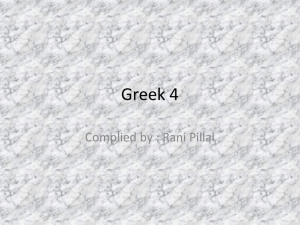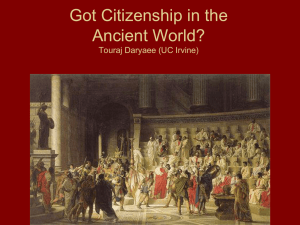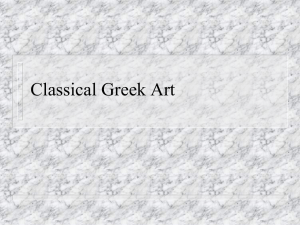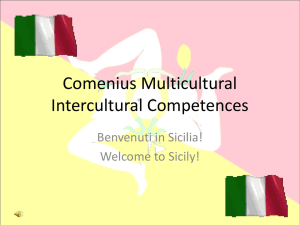Origins and Early Development of the Greek Polis
advertisement
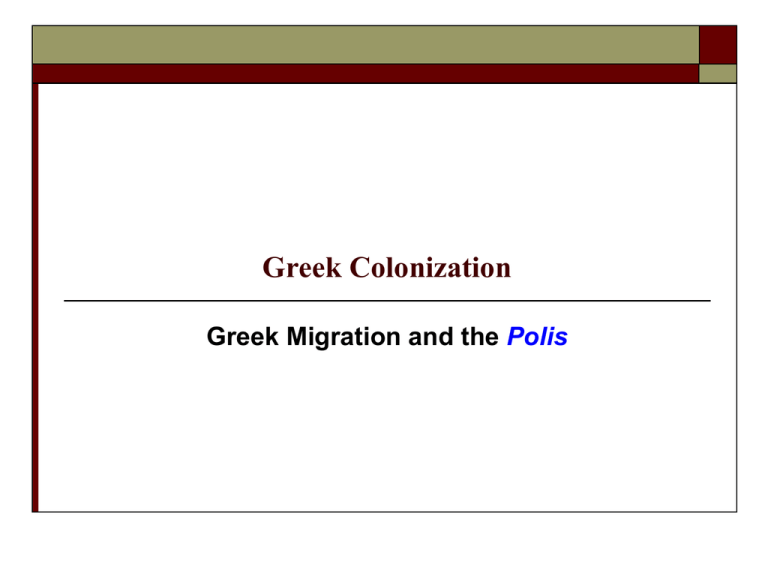
Greek Colonization Greek Migration and the Polis Homer, Odyssey, Book 9.113-32 (trans. Stanley Lombardo) A fertile island slants across the harbor’s mouth, neither very close nor very far from the Cyclop’s shore. It’s well wooded and populated with innumerable wild goats, uninhabited by human traffic. Not even hunters go there, tramping through the woods and roughing it on the mountainsides….Meadows lie by the seashore, lush and soft, where vines would thrive. It has level fields with deep, rich soil that would produce bumper crops season after season. Hesiod, Works and Days, lines 42-49 (trans. Tandy and Neale) For the gods hid and kept sustenance from people. For before this time you would easily accomplish even in one single day so as to have enough even for a full year, even if you were an idler. Quickly would you put away the steering oar up in the smoke, and the works of the oxen and the work-enduring asses would disappear. But Zeus hid it, struck with anger in his chest because Prometheus of crooked counsel had deceived him. For that very reason he contrived pernicious woes for people. Kingdoms and Colonies in the Seventh Century BCE Stages of Greek Colonization: Eastern Wave ca. 1050-950 BCE; Western Wave ca. 750-650 BCE Aeolian, Ionian, and Dorian colonization of Asia Minor (ethnē, ca. 1050-950 BCE); Miletus Greek trading emporium at Al Mina in northern Syria (ca. 800 BCE) Greek colonies in western Mediterranean--(southern Italy and Sicily): Pithecusae on island of Ischia (Euboea, ca. 760 BCE); Naxos in Sicily (Chalcis, 734 BCE); Corcyra (Corinth, 734 BCE); Syracuse in Sicily (Corinth, 734 BCE); Catana and Leontini in Sicily (Sicilian Naxos, 729 BCE); Taras in Italy (Sparta, 706 BCE); Gela in Sicily (Crete and Rhodes, 688 BCE); Himera in Sicily (Sicilian Zancle, 649 BCE) Greek foundation of Massalia [Marseilles] (Phocaea, ca. 600 BCE) Greek foundation of Cyrene in north Africa (Thera, 630 BCE) Greek foundation at Naucratis in Egypt (Hellenion, 610 BCE) Al Mina on Orontes River (northern Syria) Greek Mainland and Asia Minor Coast Dialect Map of Greece and Aegean Greek Colonization in Italy and Sicily End of Sixth Century BCE Greek Colonies in Southern Italy and Sicily Stages of Greek Colonization: Pontos or Euxine Sea (Black Sea) Mythic Memory of Colonization: Jason, Argonauts and Golden Fleece of Colchis; Odysseus’ wanderings (Circe as sister of King Aeetes of Colchis) Sinope (Miletus, before 756 BCE?; refounded ca. 600 BCE) Trapezus (Sinope, 756 BCE?) Sinope (Miletus, before 756 BCE?; refounded ca. 600 BCE) Chalcedon and Byzantium (Megara, 660 BCE) Istrus (Miletus, ca. 650 BCE?) Sigeum on the Hellespont (Athens, 600 BCE) Olbia (Miletus, ca. 550 BCE) Phasis (Miletus, ca. 550 BCE) Greek Colonies along Black Sea Coast Greeks throughout the Mediterranean (ca. 550 BCE) Greek Colonization: Causes Agricultural Poverty Deficiency of Natural Resources Land Hunger Growing Populations in Geometric Period Stasis Seafaring; Commerce; Trading Posts Sending Out the Colony Population pressures and/or stasis lead to motivation for colonization Commerce and sea-borne piracy gives Greeks geographical knowledge Selection of portion of population to go out as colonists; oecist Consultation of Delphi Colonization and the Polis Close commercial relations between mother-city (metropolis) and colony Colonization places Greek polis communities in sharp relief in comparison with indigenous forms of communal life Exposes Greeks to new cultural values, artistic styles, religious ideas, information technologies Ancient Greek Coins (Ionia and Sicily) “Orientalizing Phase” (ca. 700-600 BCE) Phoenician Colonization (Tan: Phoenician settlements; Green: Greek Settlements) Letters (Alphabet) Phoinika Herodotus, Histories, 5.58 These Phoenicians who came with Cadmus…brought to Greece, when they settled in it, various matters of learning and, very notably, the alphabet, which in my opinion had not been known to the Greeks before. At first the Phoenicians used the same letters as all the other Phoenicians; but, as time went on, as they changed their language, they also changed the shape of their letters. The Greeks who lived round about the Phoenicians at this time were mostly Ionians. They learned the alphabet from the Phoenicians, and, making a few changes in the form of the letters, they used them and, in using them, they called the letters ‘Phoenicians.’ Paradoxical Historical Development? Center and Periphery (imperial metropole and colonized subjects) Archaeology: Old Smyrna as proto-polis (Asia Minor) Greek rhetoric (rhetorikē) arises in Greek Sicily Coinage adopted by Greek poleis in proximity to Lydian Kingdom Alphabet developed by Greek communities in close proximity to Phoenician commercial colonies Greek arts influenced by Near Eastern art (“Orientalizing” period, ca. 700600 BCE) Maturation of Greek poleis: from periphery to center



